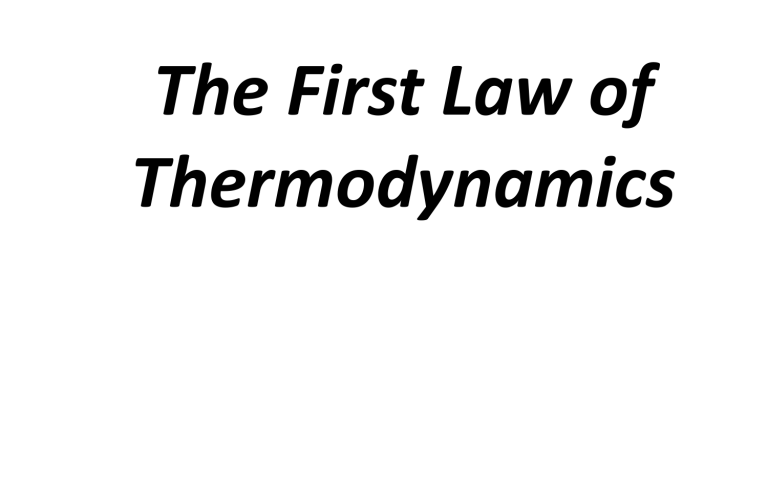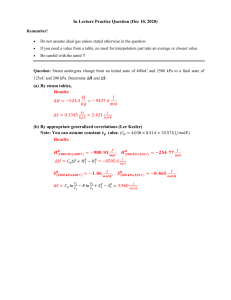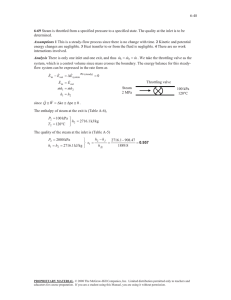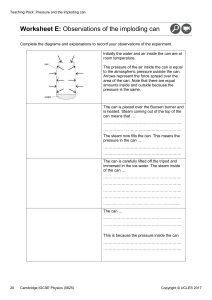
The First Law of Thermodynamics • It is the law that relates the various forms of energies for system of different types. • It is simply the expression of the conservation of energy principle. • Based on experimental observations, the first law of thermodynamics states that – “Energy can be neither created nor destroyed during a process; it can only change forms.” • For the system shown above, the conservation of energy principle or the first law of thermodynamics is expressed as Total Energy Total Energy The Change in Total = Entering the System Leaving the System Energy of the System • The total energy of the system, Esystem, is given as Ein Eout Esystem Esystem = Internal Energy + Kinetic Energy + Potential Energy Esystem = U + KE + PE • If the system does not move with a velocity and has no change in elevation, it is called a stationary system, and the conservation of energy equation reduces to Ein Eout U + KE + PE Ein Eout U Mechanisms of Energy Transfer, Ein and Eout • Heat Transfer, (Q) Heat transfer to a system (heat gain) increases the energy of the molecules and thus the internal energy of the system and heat transfer from a system (heat loss) decreases. • Work Transfer, (W) Work transfer to a system (i.e., work done on a system) increases the energy of the system, and work transfer from a system (i.e., work done by the system) decreases . • Mass Flow, (m) When mass enters a system, the energy of the system increases because mass carries energy with it (in fact, mass is energy). Likewise, when some mass leaves the system, the energy contained within the system decreases . • The energy balance can be written more explicitly as Ein Eout (Qin Qout ) (Win Wout ) ( Emass ,in Emass ,out ) ESystem • Or on a rate form, as ESystem Change in internal, kinetic, kJ Ein Eout byNetheat, energy transfer work and mass potential, etc..energies Ein Eout Rate of net energy transfer by heat, work and mass E System Rate change in internal, kinetic, potential, etc..energies kW The first law and a closed system • For the closed system where the mass never crosses the system boundary, then the energy balance is Qin -Qout +Win -Wout =E system • Closed system undergoing a cycle – For a closed system undergoing a cycle, the initial and final states are identical, and thus • The initial and final states are identical Esystem E2 E1 0 Ein Eout 0 Ein Eout Wnet ,out Qnet ,in • If the total energy is a combination of internal energy, kinetic energy and potential energy E U KE PE m(V22 V12 ) Q12 W12 U 2 U1 mg (Z 2 Z1 ) 2 • For negligible changes in kinetic and potential energy Q12 U 2 U1 W12 Internal energy and Enthalpy • Internal energy – The internal energy includes some complex forms of energy show up due to translation, rotation and vibration of molecules. – It is designated by U and it is extensive property. – Or per unit mass as, specific internal energy, u U m • If we take two phase as liquid and vapor at a given saturation pressure or temperature U U f Ug mu m f u f mg u g u u f xu fg Enthalpy • It is another extensive property which has a unit of energy and it is denoted by H. • The enthalpy is a convenient grouping of the internal energy, pressure, and volume and is given by H U PV – The enthalpy per unit mass is, h H m h= u+Pv Q12 U 2 U1 W12 W12 Pdv P(V2 V1 ) Q12 U2 U1 PV2 PV1 Q12 H 2 H1 W12 PV2 PV1 Q12 U2 PV2 U1 PV1 Specific Heat • It defined as; the energy required to raise the temperature of a unit mass of a substance by one degree. • It is an intensive property of a substance that will enable us to compare the energy storage capability of various substances. The unit is KJ Kg℃ or. KJ KgK • In thermodynamics, we are interested in two kinds of specific heats: specific heat at constant volume and specific heat at constant pressure. • The specific heat at constant volume can be viewed as the energy required to raise the temperature of the unit mass of a substance by one degree as the volume is maintained constant. • Here the boundary work is zero because the volume is constant • From first law δQ dU • Per unit mass q du q Cv dT Cv dT du du Cv dT v • The specific heat at constant pressure Cp can be viewed as the energy required to raise the temperature of the unit mass of a substance by one degree as the pressure is maintained constant. • From first law δQ dU PdV d U PV dH q C p dT • Per unit mass q dh C p dT dh dh Cp dT p Internal Energy, Enthalpy, and Specific Heats of Ideal Gases • We defined an ideal gas as a gas whose temperature, pressure, and specific volume are related by Pv RT • From the specific heat relation du Cv dT u2 u1 Cv dT • Or taking average value of specific heat for narrow temperature difference u2 u1 Cave,v (T2 T1 ) dh C p T dT h2 h1 C p dT h2 h1 Cave, p (T2 T1 ) Relation between CP and CV for Ideal Gases h u RT dh du RdT • Replacing dh by C p dT and du by Cv dT we have C p dT Cv dT RdT C p Cv R • At this point, we introduce another ideal-gas property called the specific heat ratio k, defined as K Cp Cv C p KCv Cv R K 1 Cp Cp K R KCv Cv R Cp K R K 1 Internal Energy, Enthalpy, and Specific Heats of Solids and Liquids • A substance whose specific volume (or density) is constant is called an incompressible substance. • The specific volumes of solids and liquids essentially remain constant during a process. Therefore, liquids and solids can be approximated as incompressible substances. • It can be mathematically shown that the constant-volume and constant-pressure specific heats are identical for incompressible substances. • The specific heat can be expressed as C p Cv C Example 1. The initial pressure and volume of a pistoncylinder arrangement is 200kPa and 1m3 respectively. 2000kJ of heat is transferred to the system and the final volume is 2m3. Determine the change in the internal energy of the fluid. 2. A piston–cylinder device initially contains 0.8 m3 of saturated water vapor at 250 kPa. At this state, the piston is resting on a set of stops, and the mass of the piston is such that a pressure of 300 kPa is required to move it. Heat is now slowly transferred to the steam until the volume doubles. Show the process on a P-v diagram with respect to saturation lines and determine (a) the final temperature, (b) the work done during this process, and (c) the total heat transfer. 3.A piston-cylinder contains steam initially at 1 Mpa, 450 oC and 2.5m3. Steam is allowed to cool at constant pressure until it first start condensing. Show the process on a T-v diagram with respect to saturation lines and determine. a) The mass of the steam b) The final temperature c) The amount of heat transfer 4. A piston–cylinder device initially contains steam at 200 kPa, 200°C, and 0.4 m3. At this state, a linear spring is touching the piston but exerts no force on it. Heat is now slowly transferred to the steam, causing the pressure and the volume to rise to 300 kPa and 0.6 m3, respectively. Show the process on a P-v diagram with respect to saturation lines and determine (a) the final temperature, (b) the work done by the steam, and (c) the total heat transferred. The First Law and the Control Volume • The conservation of mass and the conservation of energy principles for open systems or control volumes apply to systems having mass crossing the system boundary or control surface. • In addition to the heat transfer and work crossing the system boundaries, mass carries energy with it as it crosses the system boundaries. • Hence the conservation of mass principle can be used to relate mass which entering and leaving a system. It can be expressed as • The net mass transfer to or from a control volume during a process (a time interval t) is equal to the net change (increase or decrease) in the total mass within the control volume during that process (t). That is, Total mass entering Total mass leaving Net change in mass - = the CV during Δt the CV during Δt within the CV during Δt • Thermodynamic processes involving control volumes can be considered in two groups: steady-flow processes and unsteady-flow processes. min mout mCV ( kg ) min mout dmCV / dt (kg / s) m V Steady state process • The flow through a control volume is at steady state if, “the property of the substance at a given position within or at the boundaries of the control volume do not change with time”. • During a steady-flow process, the total amount of mass contained within a control volume does not change with time (mCV= constant). min mout dmCV / dt dmCV m CV 0 dt min m out m in mout in V in out V out V in V out in out incompressible assumption Vin Ain Vout Aout Unsteady state process • The properties within the control volume change with time but remain uniform at any instant of time. • Typical example:- filling and empting processes where most of the cases average value of properties must be used. dmcv 0 dt dmcv mi m e dt dmcv mi m e dt Flow Work and The Energy of a Flowing Fluid • Unlike closed systems, control volumes involve mass flow across their boundaries, and some work is required to push the mass into or out of the control volume. • This work is known as the flow work, or flow energy. W flow F PA FL PAL PV ( kJ ) w flow Pv w flow,in Pv and w flow,exit Pe ve i i W flow,in ( Pv i i ) mi and W flow,exit ( Pe ve ) me W flow Peve me Pv i i mi W W flow W cv Development of energy balance • The general representation of the first law of thermodynamics Q12 W12 E2 E1 • The first law for open system will also have the same form, but W12 W flow Wcv E =U +KE+PE E = Internal Energy + Kinetic Energy + Potential Energy • The fluid entering or leaving a control volume possesses an additional V2 form of energy, the flow energy Pv e u ke pe u gz 2 • Then the total energy of a flowing fluid on a unit-mass basis (denoted by) becomes Pv e Pv (u ke pe) • But the combination Pv + u has been previously defined as the enthalpy h. So the relation in the above equation reduces to V2 h ke pe h gz 2 ( kJ / kg ) • For inlet V 2i ei Pv gzi Pv i i ui i i 2 V 2i ei Pv gzi i i hi 2 • For outlet V 2e ee Pe ve he gze 2 • General equation Ein Eout dEsystem / dt 0( steady ) 0 Qin Win m Qout Wout m in out V2 V2 Qin Win m(h gz ) Qout Wout m(h gz ) 2 2 in out • In such cases, it is common practice to assume heat to be transferred into the system (heat input) at a rate of Q, and work produced by the system (work output) at a rate of W , and then solve the problem. The first-law or energy balance relation in that case for a general steady-flow system becomes V22 V12 Q W m h2 h1 g ( z2 z1 ) 2 V22 V12 q w h2 h1 g ( z2 z1 ) 2 • When the fluid experiences negligible changes in its kinetic and potential energies (that is, ke = 0, pe = 0), the energy balance equation is reduced further to q w h2 h1 Some Steady-Flow Engineering Devices Nozzles and Diffusers • Nozzles and diffusers are commonly utilized in jet engines, rockets, spacecraft, and even garden hoses. • A nozzle is a device that increases the velocity of a fluid at the expense of pressure. • A diffuser is a device that increases the pressure of a fluid by slowing it down. Ein Eout min m out m1 m2 m Vi 2 Ve2 Qnet mi hi gzi W net me he gze 2 2 inlet exit Vi 2 Ve2 mi hi me he 2 2 Ve 2(hi he ) Vi 2 Turbines • In steam, gas, or hydroelectric power plants, the device that drives the electric generator is the turbine. • As the fluid passes through the turbine, work is done against the blades, which are attached to the shaft. As a result, the shaft rotates, and the turbine produces work. Ein Eout min m out m1 m2 m Vi 2 Ve2 Qnet mi hi gzi W net me he gze 2 2 inlet exit mi hi m e h e W out W out m(hi he ) Compressors • Compressors, as well as fans, are devices used to increase the pressure of a fluid. • Work is supplied to these devices from an external source through a rotating shaft. Vi 2 Ve2 Qnet mi hi gzi W net me he gze 2 2 inlet exit min m out W net m(he hi ) W net m(hi he ) Pumps • The work required when pumping an incompressible liquid in an adiabatic steady-state, steady-flow process is given by V22 V12 Q W m h2 h1 g ( z2 z1 ) 2 • The enthalpy difference can be written as h2 h1 u2 u1 Pv 2 Pv 1 • The pumping process for an incompressible liquid is essentially isothermal, and the internal energy change is approximately zero. Since v2 = v1 = v the work input to the pump becomes V V W m v P2 P1 2 2 2 1 2 W m v P2 P1 g ( z2 z1 ) W in, pump m v P2 P1 Throttling Valves • Throttling valves are any kind of flow-restricting devices that cause a significant pressure drop in the fluid. • The pressure drop in the fluid is often accompanied by a large drop in temperature, and for that reason throttling devices are commonly used in refrigeration and air-conditioning applications. Vi 2 Ve2 Qnet mi hi gzi W net me he gze 2 2 inlet exit min m out mi h i m e h e hi h e Mixing Chambers • The mixing of two fluids occurs frequently in engineering applications. The section where the mixing process takes place is called a mixing chamber. • The ordinary shower is an example of a mixing chamber. E in E out Vi 2 Ve2 Qnet mi hi gzi W net me he gze 2 2 inlet exit m1 h1 m 2 h 2 m3 h3 m in mout m1 m 2 m3 m 2 m3 m1 m1 h1 m3 m1 h 2 m3 h3 m1 (h1 h 2 ) m3 (h3 h 2 ) m1 m3 ( h3 h 2 ) (h1 h2 ) Heat Exchangers • Heat exchangers are normally well-insulated devices that allow energy exchange between hot and cold fluids without mixing the fluids. min m out m1 m 2 m w m3 m 4 m R E in E out Vi 2 Ve2 Qnet mi hi gzi W net me he gze 2 2 inlet exit m1 h1 m3 h3 m 2 h 2 m 4 h 4 m w (h1 h 2 ) m R (h 4 h3 ) Example 1.Steam at 0.4 MPa, 300 oC, enters an adiabatic nozzle with a 1m/sec and leaves at 0.2MPa with a quality of 90%. Find the exit velocity, in m/s. 2. Steam flows steadily through an adiabatic turbine. The inlet conditions of the steam are 4 MPa, 500°C, and 80 m/s, and the exit conditions are 30 kPa, 92 percent quality, and 50 m/s. The mass flow rate of the steam is 12 kg/s. Determine (a) the change in kinetic energy, (b) the power output, and (c) the turbine inlet area. 3. The power output of an adiabatic steam turbine is 5 MW, and the inlet and the exit conditions of the steam are as indicated in Figure below. a) Compare the magnitudes of h, ke, and pe. b) Determine the work done per unit mass of the steam flowing through the turbine. c) Calculate the mass flow rate of the steam. 3. Nitrogen gas is compressed in a steady-state, steady-flow, adiabatic process from 0.1 Mpa, 25 oC. During the compression process the temperature become 125 oC. If the mass flow rate is 0.2kg/s, determine the work done on the nitrogen, in kW. (use cp=1.039kJ/kg.K) 4. Saturated steam at 0.4 MPa is throttled to 0.1MPa, 100 oC. Determine the quality of the steam at 0.4MPa. 5. Steam at 0.2MPa, 300oC, enters a mixing chamber and is mixed with cold water at 20oC, 0.2MPa, to produce 20kg/s of saturated liquid at 0.2MPa. What are the required steam and cold water flow rates? 6. Two tanks (Tank A and Tank B) are separated by a partition. Initially Tank A contains 2-kg steam at 1 MPa and 300°C while Tank B contains 3-kg saturated liquid–vapor mixture with a vapor mass fraction of 50 percent. Now the partition is removed and the two sides are allowed to mix until the mechanical and thermal equilibrium are established. If the pressure at the final state is 300 kPa, determine (a) the temperature and quality of the steam (if mixture) at the final state and (b) the amount of heat lost from the tanks. 7. Air enters an adiabatic nozzle steadily at 300 kPa, 400°C, and 30 m/s and leaves at 250kPa and 33m/s. The inlet area of the nozzle is 0.08 m2. Determine (a) the mass flow rate through the nozzle, (b) the exit temperature of the air, and (c) the exit area of the nozzle. 9. Refrigerant-134a is throttled from the saturated liquid state at 700 kPa to a pressure of 160 kPa. Determine the temperature drop during this process and the final specific volume of the refrigerant. 10. In steam power plants, open feedwater heaters are frequently utilized to heat the feedwater by mixing it with steam bled off the turbine at some intermediate stage. Consider an open feedwater heater that operates at a pressure of 1000 kPa. Feedwater at 50°C and 1000 kPa is to be heated with superheated steam at 200°C and 1000 kPa. In an ideal feedwater heater, the mixture leaves the heater as saturated liquid at the feedwater pressure. Determine the ratio of the mass flow rates of the feedwater and the superheated vapor for this case. 11. An adiabatic air compressor is to be powered by a direct-coupled adiabatic steam turbine that is also driving a generator. Steam enters the turbine at 12.5 MPa and 500°C at a rate of 25 kg/s and exits at 10 kPa and a quality of 0.92. Air enters the compressor at 98 kPa and 295 K at a rate of 10 kg/s and exits at 1 MPa and 620 K. Determine the net power delivered to the generator by the turbine.





